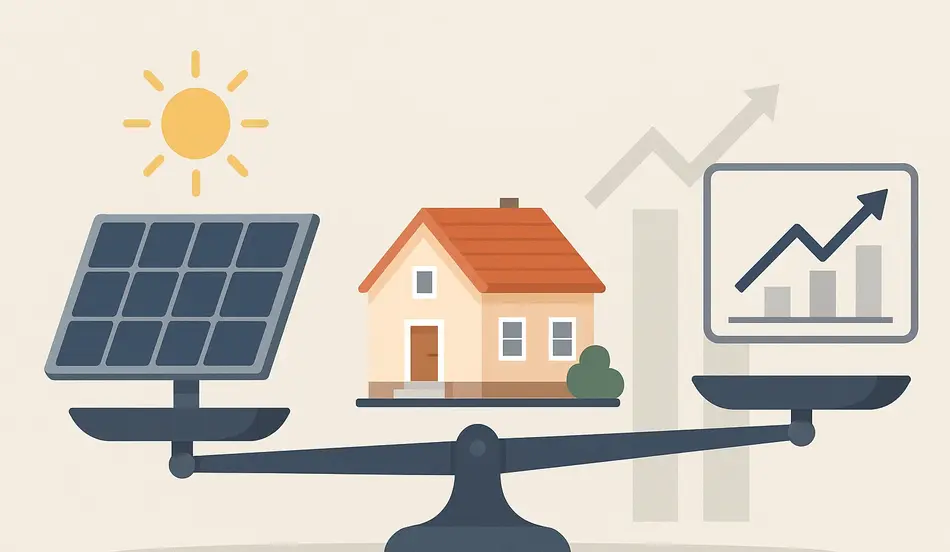The $600 billion solar industry represents one of the most compelling investment opportunities available today, offering significantly better returns and lower risk than traditional investment vehicles like real estate or stocks. While most investors default to familiar options like real estate for slow, steady payouts or gamble in the volatile stock market, there’s a safer route that pays for itself in months rather than years, with none of the market swings that plague traditional investments.
This comprehensive guide explores why the Solar DFY Model Better than Real Estate or Stocks, examining the limitations of traditional investments and revealing how solar investments provide life-changing cash flow with predictable, linear returns that aren’t subject to market volatility.
Key Investment Advantages:
- Immediate returns – 2-4 month payback period vs years for traditional investments
- Higher returns – 50-100% cash-on-cash returns vs 6-12% for real estate
- Predictable performance – Linear returns based on historical data
- No market volatility – Not subject to external market forces
- Professional management – Complete done-for-you service
The residential solar market, in particular, offers exceptional opportunities for investors willing to explore alternative investment strategies that provide both financial returns and environmental impact.
Solar Industry Benefits:
- Massive market size – $600 billion industry with continued growth
- Government support – Tax credits and incentives reduce investment risk
- Environmental benefits – Aligns with sustainability goals
- Predictable returns – Historical data shows consistent performance
- Immediate cash flow – Returns begin within months, not years
Solar: A $600B Investment Opportunity
As solar energy scales faster than real estate or stocks, the industry is set for massive growth. Employers who act now can secure top talent in a booming sector. Post your job on WhatJobs today and connect with professionals ready to power the future — free for 30 days.
Post a Job Free for 30 Days →The Real Estate Investment Reality: Limited Returns and High Barriers
Traditional Real Estate Challenges
Real estate has long been considered one of the safest investment vehicles, but the reality is far more complex than most investors realize. While there are multiple avenues within real estate—including fix and flip, buy and hold, rental properties, and multifamily investments—success requires extensive knowledge and experience.
Common Real Estate Investment Pitfalls:
- Knowledge requirements – You must know what you’re doing to avoid significant losses
- Limited returns – Typical returns range from 6-12% annually
- Long-term commitment – Not designed for immediate cash flow generation
- Market dependency – Subject to real estate cycles and economic conditions
- High barriers to entry – Requires substantial capital and expertise
The fundamental issue with real estate investing is that it’s primarily a long-term wealth-building strategy where you park your money and wait for appreciation over decades. While this approach can work for those with extensive knowledge and experience, it doesn’t provide the immediate, life-changing cash flow that many investors seek.
Why Real Estate Falls Short for Immediate Returns
Real estate investments typically require years to show meaningful returns, and even then, the cash flow is often modest compared to alternative investment opportunities. The 6-12% annual returns, while steady, don’t provide the exponential growth potential that can truly transform your financial situation.
Real Estate Limitations:
- Slow appreciation – Properties may take years to show significant value increases
- Maintenance costs – Ongoing expenses can eat into profits
- Market timing – Success often depends on buying and selling at the right times
- Liquidity issues – Difficult to quickly access capital when needed
- Management overhead – Requires active involvement or expensive property management
For investors seeking immediate cash flow and higher returns, traditional real estate simply cannot compete with more dynamic investment opportunities in the solar industry.
Stock Market Volatility: The Unpredictable Gamble
The Volatility Problem
The stock market represents perhaps the most unpredictable investment vehicle available to individual investors. Market movements can be influenced by everything from social media posts to geopolitical events, making it nearly impossible to predict short-term performance with any degree of certainty.
Stock Market Challenges:
- Extreme volatility – Markets can shift dramatically based on tweets and social media
- Unpredictable factors – External influences make performance impossible to forecast
- Emotional investing – Fear and greed drive irrational decision-making
- Limited control – Investors have no influence over company performance or market conditions
- Long-term focus required – Immediate returns are rare and unpredictable
The S&P 500, considered the safest stock market investment, typically provides around 10% annual returns through compound interest. However, this approach requires decades of patience and offers no immediate cash flow benefits.
Why Stocks Don’t Work for Immediate Cash Flow
Stock market investing is fundamentally incompatible with the goal of generating immediate, life-changing cash flow. The traditional approach involves pumping money into the market and hoping for better returns in 20-30 years, which doesn’t help investors who need income now.
Stock Market Limitations:
- No immediate cash flow – Returns are primarily through long-term appreciation
- Market dependency – Performance tied to overall market conditions
- No control over outcomes – Investors are passive participants
- Emotional stress – Constant market fluctuations create anxiety
- Timing challenges – Success often depends on market timing rather than skill
For investors seeking immediate returns and portfolio diversification that provides monthly income, the stock market simply cannot deliver the results needed to achieve financial independence.
Solar: A $600B Investment Opportunity
As solar energy scales faster than real estate or stocks, the industry is set for massive growth. Employers who act now can secure top talent in a booming sector. Post your job on WhatJobs today and connect with professionals ready to power the future — free for 30 days.
Post a Job Free for 30 Days →The Solar Industry: A $600 Billion Opportunity
Why Solar Investment Makes Sense
The solar industry represents a massive, growing market with unique characteristics that make it superior to traditional investment vehicles. Unlike real estate or stocks, solar investments offer predictable returns, immediate cash flow, and protection from market volatility.
Solar Industry Advantages:
- Massive market size – $600 billion industry with continued growth
- Government support – Tax credits and incentives reduce investment risk
- Environmental benefits – Aligns with sustainability goals
- Predictable returns – Historical data shows consistent performance
- Immediate cash flow – Returns begin within months, not years
The residential solar market, in particular, offers exceptional opportunities for investors willing to explore alternative investment strategies that provide both financial returns and environmental impact.
Tax Credit Strategies and Benefits
One of the most significant advantages of solar investments is the ability to leverage various tax credits and incentives. While many investors worry about expiring tax credits, sophisticated strategies can maximize these benefits regardless of policy changes.
Tax Credit Advantages:
- Federal Investment Tax Credit (ITC) – Significant upfront savings
- Depreciation benefits – Additional tax advantages for commercial applications
- Interest deductions – Ability to write off loan interest
- State incentives – Additional benefits vary by location
- Strategic implementation – Professional management maximizes all available benefits
The key to maximizing solar investment returns lies in understanding and implementing the right tax strategies, which can significantly reduce the effective cost of solar installations while maintaining all the financial benefits.
Solar: A $600B Investment Opportunity
As solar energy scales faster than real estate or stocks, the industry is set for massive growth. Employers who act now can secure top talent in a booming sector. Post your job on WhatJobs today and connect with professionals ready to power the future — free for 30 days.
Post a Job Free for 30 Days →The DFY Solar Investment Model: How It Works
Understanding the Done-For-You Approach
The Solar DFY Model Better than Real Estate or Stocks because it eliminates the need for investors to become solar experts or manage complex installations. This approach provides a complete investment solution where professionals handle all aspects of the business while investors receive predictable returns.
DFY Model Benefits:
- Complete management – Professionals handle all operational aspects
- Predictable returns – Historical data shows 50-100% cash-on-cash returns
- Quick payback – Initial investment typically paid off in 2-4 months
- No volatility – Returns not subject to market fluctuations
- Scalable opportunity – Can be expanded based on available capital
This model works by connecting qualified homeowners with solar solutions while providing investors with a share of the profits generated from each successful installation.
The Appointment-Based System
Unlike traditional marketing approaches that are subject to advertising volatility, the solar DFY model uses a pay-per-result system that provides predictable outcomes and eliminates market risk.
Appointment System Advantages:
- Credit-qualified leads – Only pre-qualified homeowners receive appointments
- Predictable conversion rates – Historical data shows 1 in 2-3 appointments close
- No advertising volatility – Not subject to changing ad costs or market conditions
- Linear returns – Performance is consistent and predictable
- Professional closers – Experienced sales teams handle all customer interactions
This system ensures that marketing dollars are spent efficiently, with clear data on expected returns from each appointment, eliminating the guesswork that plagues other investment approaches.
Financial Performance: Comparing Returns
Historical Performance Data
The solar DFY model has consistently outperformed traditional investment vehicles, providing investors with returns that far exceed what’s possible through real estate or stock market investments.
Performance Comparison:
- Solar DFY Model – 50-100% cash-on-cash returns
- Real Estate – 6-12% annual returns
- S&P 500 – ~10% annual returns (long-term)
- Solar Payback Period – 2-4 months
- Real Estate Payback – 8-17 years
- Stock Market Payback – 7-10 years (rule of 72)
These numbers clearly demonstrate why the Solar DFY Model Better than Real Estate or Stocks for investors seeking immediate, life-changing returns.
Risk Mitigation Strategies
Unlike traditional investments that are subject to market volatility, the solar DFY model provides multiple layers of risk protection that ensure consistent returns regardless of economic conditions.
Risk Mitigation Features:
- Pay-per-result model – Only pay for qualified appointments, not advertising
- Credit qualification – All leads are pre-screened for creditworthiness
- Professional management – Experienced teams handle all operations
- Diversified approach – Multiple revenue streams reduce single-point-of-failure risk
- Proven track record – Historical data validates performance claims
This approach eliminates the uncertainty that comes with traditional investments while providing the high returns that can truly transform an investor’s financial situation.
Getting Started: Investment Requirements and Process
Minimum Investment and Qualifications
The solar DFY model is designed for serious investors who want to diversify their portfolio with a high-performing alternative investment opportunity.
Investment Requirements:
- Minimum capital – $50,000 in liquid funds required
- Investment mindset – Understanding of alternative investment strategies
- Long-term perspective – Commitment to building sustainable wealth
- Professional partnership – Willingness to work with experienced teams
- Growth orientation – Interest in scalable investment opportunities
This investment level ensures that participants are serious about building wealth while providing access to an opportunity that can generate life-changing returns.
The Partnership Process
Getting started with the solar DFY model involves a structured process designed to ensure success for both investors and the companies they partner with.
Partnership Steps:
- Initial consultation – Detailed explanation of the investment model
- Due diligence – Review of historical performance data and strategies
- Investment planning – Development of customized investment approach
- Setup and launch – Professional assistance with business establishment
- Ongoing management – Continuous support and optimization
This process ensures that investors understand exactly what they’re investing in and how the returns are generated, providing confidence in the investment decision.
Frequently Asked Questions
Q: How does the Solar DFY Model Better than Real Estate or Stocks in terms of returns?
A: The Solar DFY Model Better than Real Estate or Stocks because it provides 50-100% cash-on-cash returns compared to 6-12% for real estate and ~10% for stocks. Additionally, solar investments pay back within 2-4 months versus years for traditional investments, providing immediate cash flow and life-changing returns.
Q: What makes solar investments less risky than stock market investments?
A: Solar investments eliminate market volatility through a pay-per-result model where you only pay for credit-qualified appointments. The Solar DFY Model Better than Real Estate or Stocks because it’s not subject to social media posts, market fluctuations, or advertising cost changes that can dramatically affect other investment returns.
Q: How do solar tax credits work and why are they beneficial for investors?
A: Solar investments leverage multiple tax strategies including federal ITC, depreciation benefits, and interest deductions. The Solar DFY Model Better than Real Estate or Stocks because it maximizes these tax advantages through professional management, often providing homeowners with immediate cash payments while investors benefit from the tax credits.
Q: What is the minimum investment required and how quickly can I expect returns?
A: The minimum investment is $50,000 in liquid funds, and investors typically see their initial investment paid back within 2-4 months. The Solar DFY Model Better than Real Estate or Stocks because it provides immediate cash flow rather than requiring years of waiting for returns like traditional investments.
The Bottom Line: Why Solar Investment Wins
The Solar DFY Model Better than Real Estate or Stocks because it combines the best aspects of both traditional investments while eliminating their major drawbacks. Unlike real estate, it provides immediate cash flow and higher returns. Unlike stocks, it offers predictable performance without market volatility.
Key Advantages:
- Immediate returns – 2-4 month payback period
- High returns – 50-100% cash-on-cash returns
- Predictable performance – Linear returns based on historical data
- No market volatility – Not subject to external market forces
- Professional management – Complete done-for-you service
- Scalable opportunity – Can grow with available capital
For investors with at least $50,000 in liquid funds who want to diversify their portfolio with a high-performing alternative investment, the solar DFY model offers an unparalleled opportunity to generate life-changing returns while contributing to environmental sustainability.




